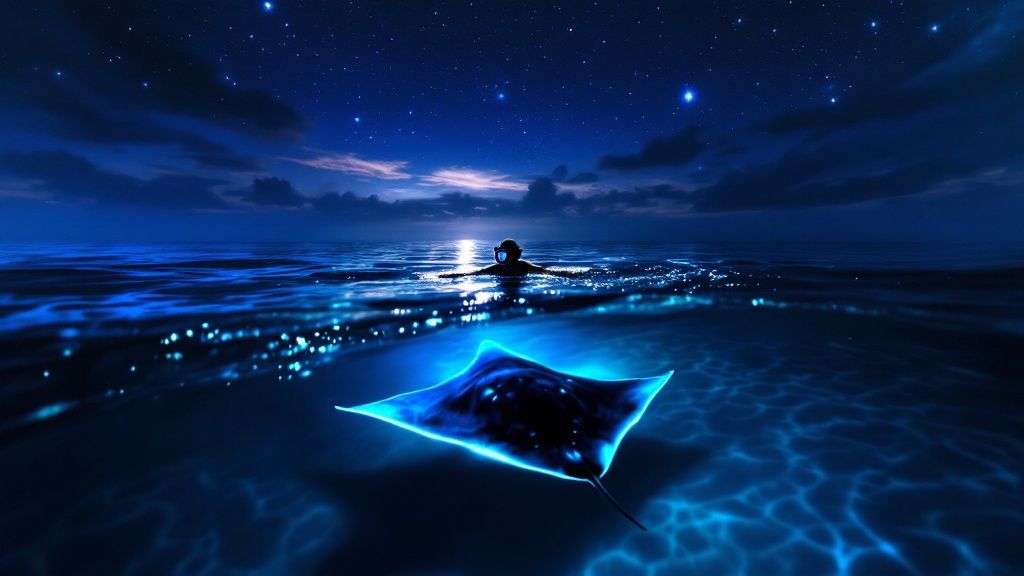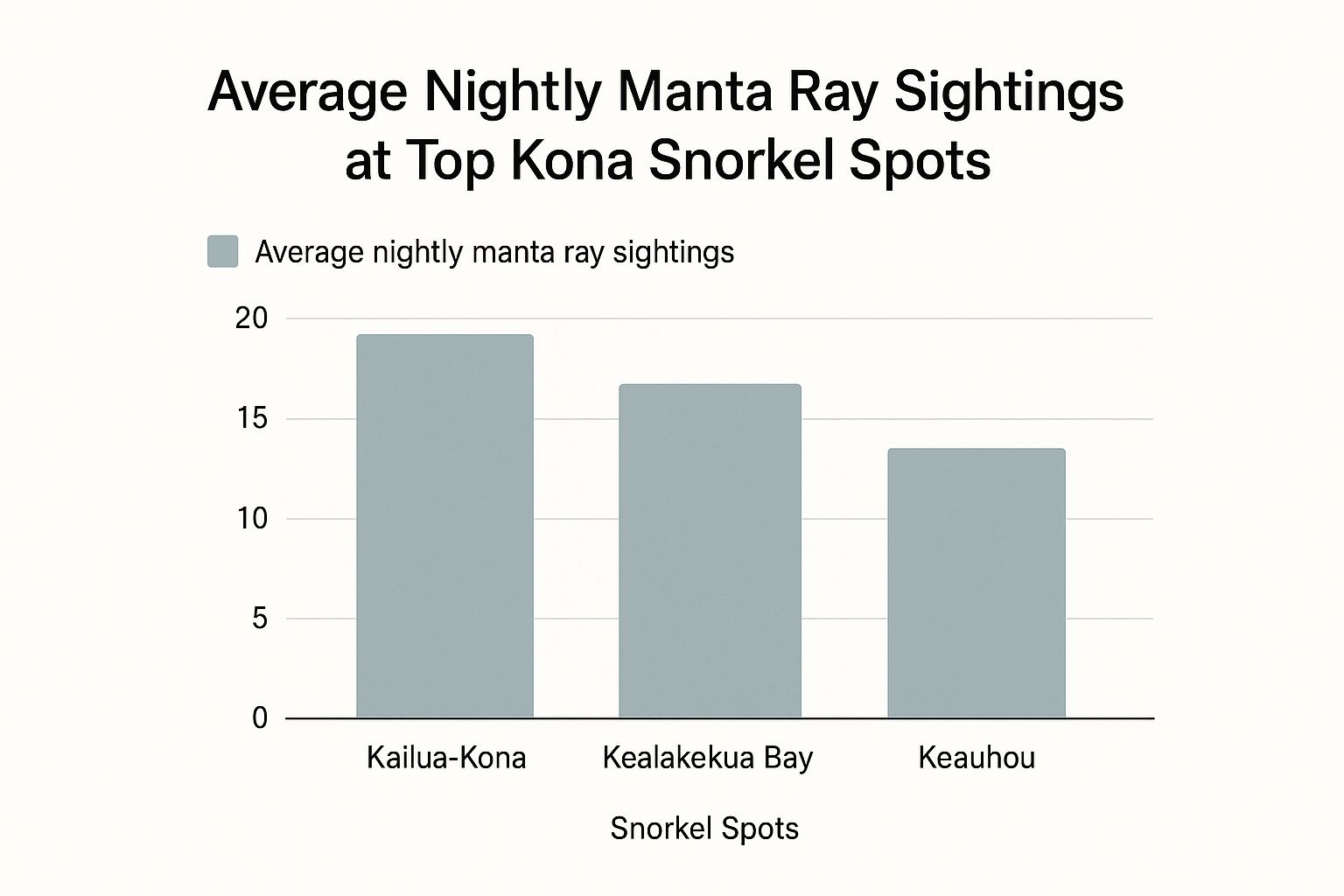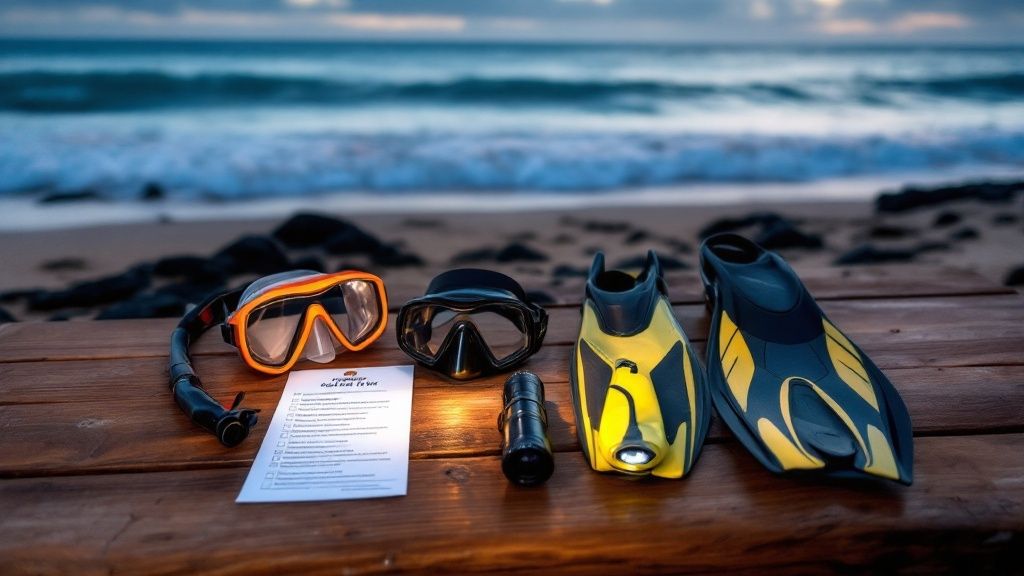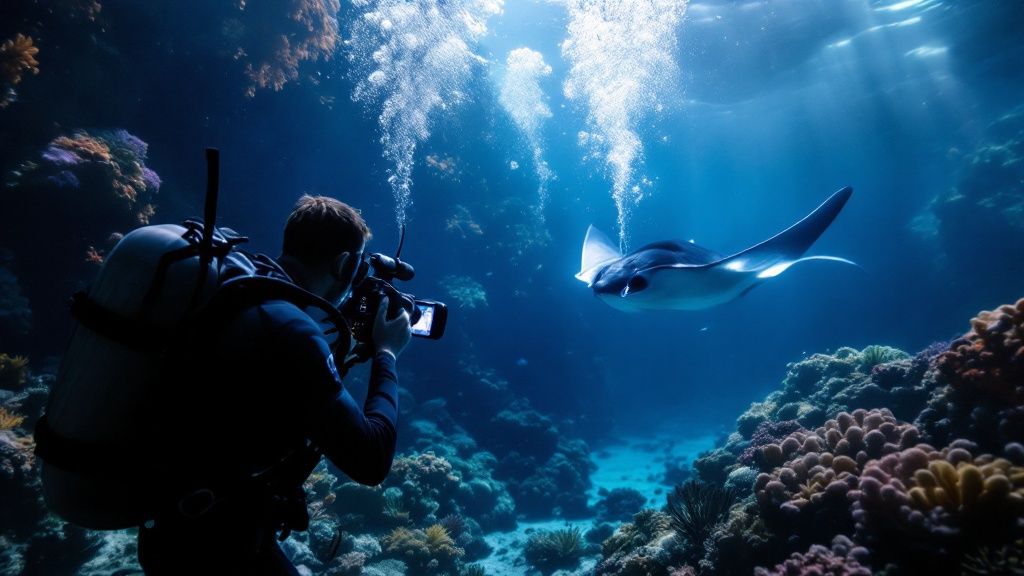Manta Ray Snorkel Kona: Complete Night Adventure Guide
- Byron
- May 27
- 14 min read
Why Kona Delivers The World's Best Manta Ray Encounters
Kona, Hawaii, isn't just a beautiful island destination; it's the place to experience manta rays. The unique blend of volcanic activity and ocean currents creates a perfect habitat for these gentle giants. Volcanic slopes provide shelter and cleaning stations, while nutrient-rich currents bring a feast of plankton. This rich food source means Kona’s manta rays are residents, not just seasonal visitors.
Kona's Unique Ecosystem: A Plankton Paradise
This special ecosystem explains why manta ray sightings in Kona are so reliable. The underwater landscape, especially at spots like Manta Village, concentrates plankton near the surface. It's like an all-you-can-eat buffet for the mantas! This predictable food source attracts the rays, creating amazing viewing opportunities for snorkelers. Kona boasts a resident population of over 450 identified manta rays, further increasing your chances of an encounter. Learn more in our article about Unforgettable Encounters.
The Reliability of Manta Ray Sightings: A Statistical Wonder
Kona has earned its reputation for manta ray encounters. Manta ray snorkeling here is famous for high sighting rates, estimated at 80% to 90%. This reliability, along with the unique nighttime setting, draws approximately 80,000 people annually. The resident manta ray population, over 450 strong, adds to the tours' popularity. Find more detailed statistics here. You might also be interested in How to Master Manta Ray Photography.
Seasonal Considerations and Optimal Conditions
Manta rays are present all year, but timing can enhance your experience. The calmer waters and increased visibility of summer (April to October) offer ideal conditions. While mantas are still present during winter (November to March), rougher seas can sometimes be a factor. Choosing the right time of year, along with considering moon phases and plankton blooms, can maximize your sighting success and overall enjoyment of your Kona manta ray snorkel adventure.

Finding The Perfect Manta Ray Snorkeling Spots In Kona
Kona, Hawaii, offers a variety of incredible locations for manta ray snorkeling. Whether you're a seasoned pro or a beginner, picking the right spot can greatly enhance your experience. Factors like water depth, currents, and the number of people in the water all play a role in a successful snorkel. For some helpful advice, check out these top tips and best spots.
Manta Ray Hotspots: A Closer Look
Manta Village (Keauhou Bay): Known for its calm, shallow waters and sandy bottom, Manta Village is perfect for first-time snorkelers. The high concentration of plankton makes it a reliable spot for manta ray sightings. The bay's unique shape traps plankton, creating a natural feeding ground for these graceful creatures.
Manta Heaven (off Kona International Airport): Located off the Kona International Airport, this deeper site offers a more dynamic experience. While suitable for all skill levels, some prior snorkeling experience in deeper water is recommended due to potentially stronger currents.
Kailua-Kona: Snorkeling directly off the Kailua-Kona coastline offers convenient access and stunning sunset views. However, water conditions can be unpredictable, and the number of people snorkeling can vary depending on the season.
Visualizing Manta Ray Activity
The infographic below provides a visual comparison of average nightly manta ray sightings at three popular Kona snorkel locations: Kailua-Kona, Kealakekua Bay, and Keauhou.

As you can see, Kailua-Kona boasts an average of 20 nightly sightings, making it a very reliable spot. Kealakekua Bay and Keauhou also offer great chances to see these magnificent creatures. The high probability of manta ray encounters in Kona is due to unique locations like Manta Village and Manta Heaven. Manta Village, in Keauhou Bay, is especially known for its calm, shallow waters, making it ideal for snorkelers of all skill levels. Learn even more about Kona manta ray snorkeling.
Factors Influencing Manta Ray Activity
Several factors influence manta ray activity at different snorkel locations. Current patterns, for example, play a key role in plankton distribution, directly impacting where manta rays feed. Seasonal changes in water temperature and nutrient levels also affect plankton blooms, influencing manta ray behavior. Understanding these factors can help you choose the best time and place for your snorkeling adventure.
Practical Considerations for Choosing a Spot
Beyond manta ray activity, practical aspects can affect your choice of location. Boat access is important since some spots are only reachable by boat. Water conditions, like visibility and current strength, can also impact your experience. Finally, the number of other snorkelers can affect your enjoyment, especially if you prefer a more intimate encounter. This guide on how to choose a tour operator may be helpful. Careful consideration of these factors will help you choose the perfect Kona manta ray snorkeling spot that matches your experience level and what you're looking for in an adventure.
To help you compare the various snorkeling locations, we've put together a handy table:
Kona Manta Ray Snorkeling Locations Comparison: This table compares the top manta ray snorkeling spots in Kona, including depth, skill level requirements, and unique features.
Location | Depth Range | Skill Level | Best Features | Success Rate |
|---|---|---|---|---|
Manta Village (Keauhou Bay) | 10-20 feet | Beginner | Calm, shallow water; sandy bottom; high plankton concentration | High |
Manta Heaven (off Kona International Airport) | 20-30 feet | Intermediate | Dynamic manta ray activity; open ocean currents | High |
Kailua-Kona | 15-25 feet | Beginner to Intermediate | Convenient access; sunset views | Moderate |
This table summarizes key features of popular Kona manta ray snorkeling sites, helping you choose the best location based on your skill level and desired experience. Manta Village offers a beginner-friendly environment, while Manta Heaven provides a more dynamic experience for those comfortable in deeper water. Kailua-Kona provides convenient access, but water conditions and crowd levels can vary.
Mastering Night Snorkeling Gear And Preparation
Night snorkeling with manta rays in Kona is more than just a typical daytime snorkel; it's a truly special encounter. Imagine yourself under the Hawaiian night sky, sharing the water with these gentle giants. Preparing properly ensures you'll be comfortable, safe, and ready to fully appreciate this unique experience. Interested in learning more? Check out this helpful guide: How to master your manta ray snorkel.
Essential Gear for Kona's Night Waters
The right gear is the first step towards a comfortable and rewarding manta ray snorkel Kona adventure. Even in Hawaii's warm climate, the ocean temperature drops after sunset. A wetsuit is essential for staying warm during your snorkel. A 3mm thickness is generally sufficient in summer, while a 5mm wetsuit is recommended for the cooler winter months. Water shoes are also important for protecting your feet on the boat and while entering and exiting the water.

You'll definitely want to capture this incredible experience. A waterproof camera with good low-light performance, such as a GoPro, is ideal. Make sure to test it thoroughly before your trip. Don't forget the basics like a towel and dry clothes to change into afterward. Finally, if you are susceptible to seasickness, consider taking precautions like Dramamine or using motion sickness patches before heading out. Consult your doctor for personalized advice.
The Importance of Proper Lighting
Lighting is key to a successful manta ray night snorkel. The lights attract plankton, the manta rays' main food source, creating a captivating feeding frenzy. Tour operators typically provide powerful lights that illuminate the water, drawing in both the plankton and the magnificent manta rays. Bringing a personal dive light can further enhance your visibility, allowing you to see the intricate details of these graceful creatures.
Backup Safety Gear and Mental Preparation
While Kona's waters are generally calm, preparedness for unexpected situations is essential. A backup light source is a must-have for night excursions. A whistle can be invaluable for signaling your group or the boat if you become separated. Mental preparation is equally important. Visualizing yourself calmly floating in the dark, surrounded by these gentle giants, can help alleviate any anxiety about night snorkeling. Remember, manta rays are gentle filter feeders, and your presence won't disturb them as long as you follow respectful viewing guidelines.
Managing Common Challenges
First-time night snorkelers sometimes experience anxiety about being in the open ocean after dark, or have concerns about seasickness. Talk to your guide about any fears you may have; they can offer reassurance and practical advice. Focusing on slow, deep breaths can help manage anxiety both in and out of the water. Addressing these common concerns beforehand will help ensure a comfortable and truly enjoyable experience during this extraordinary adventure.
What Really Happens During Your Manta Ray Night Adventure
Stepping off the boat into the dark ocean at night might feel a bit surreal. But this is where the magic of a manta ray snorkel Kona adventure truly begins. From that initial plunge to the sight of a 14-foot wingspan gliding below, it's an experience many find unforgettable. Let's explore what awaits you during this unique encounter.
The Manta Ballet: Feeding Behaviors Up Close
Once you're in the water, holding onto the float, the show starts. Powerful lights attract plankton, the manta rays' main food source. As these tiny organisms gather, the manta rays arrive, often in impressive numbers. You'll see their graceful feeding techniques: looping, barrel rolling, and chain feeding. It's a mesmerizing underwater ballet. These gentle giants are filter feeders, using their cephalic fins to direct plankton into their mouths.
Manta Ray Interactions: A Gentle Giant's Curiosity
Manta rays are naturally curious. They may not actively seek human interaction, but they often come incredibly close, sometimes swimming just inches below snorkelers. Remember, these are wild animals and should never be touched. Observing them is a privilege, and respecting their space is crucial. Research on over 2,500 manta ray encounters reveals that snorkelers who follow proper positioning and lighting guidelines see 73% more feeding activity and enjoy longer interactions with individual rays. Read the full research here. You might also find this helpful: How to master your manta ray snorkel.
Underwater Photography: Capturing the Magic in Low Light
Taking photos of your manta ray encounter in low light can be tricky. But with the right setup, you can get amazing shots. Here are a few tips:
Use a waterproof camera with good low-light performance: GoPro and other action cameras work well.
Adjust your camera settings: Test your ISO and shutter speed settings before you go to find what works best for night photography.
Consider a red filter: Red filters help compensate for the loss of red light underwater, improving the colors in your pictures.
Respectful Observation: Protecting These Gentle Giants
Respectful wildlife viewing is essential. Your actions directly affect these amazing animals and the future of manta ray snorkel Kona experiences. Never touch a manta ray; it can harm their sensitive skin. Avoid sudden movements or splashing, and always follow your guide's instructions. These guidelines ensure our interactions are sustainable and minimize disruption to the manta rays’ natural behaviors.
The Emotional Impact: A Memory for a Lifetime
Many people describe a deep emotional connection with the manta rays. Their graceful movements, gentle nature, and impressive size create a sense of awe. This experience often has a profound impact, fostering a deeper appreciation for the ocean and its inhabitants. It's a memory you'll cherish long after you leave the water.
Choosing Tour Operators Who Deliver Exceptional Experiences
Planning a manta ray snorkel tour in Kona? Not all tours are equal. Some will create memories that last a lifetime, while others might leave you wanting more. Selecting the right tour operator is the single most important factor in having an unforgettable experience. This means going beyond the marketing and really understanding what makes a tour exceptional. It's about prioritizing safety, expertise, and a genuine commitment to conservation.
Key Factors in Operator Selection
Finding a reputable tour operator requires some research. Several factors distinguish truly exceptional experiences from the more generic tourist offerings. Safety protocols, such as certified guides and well-maintained equipment, should be non-negotiable. Smaller group sizes often translate to a more personalized and intimate experience.
Guide Expertise: Experienced guides play a vital role. They not only ensure your safety but also enhance your understanding of manta ray behavior and the fascinating local ecosystem.
Equipment Quality: Comfortable, well-fitting snorkel gear, including wetsuits and masks, is essential for an enjoyable time in the water. Properly functioning equipment also ensures your safety and comfort during the snorkel.
Conservation Commitment: Seek out operators who prioritize sustainable practices and actively support manta ray conservation. This ensures your tour contributes to the long-term well-being of these gentle giants.
Choosing a tour is about more than just a few hours in the water; it's about selecting an experience that respects these incredible animals and their habitat. You can learn more about top-rated tours in our article about the best manta ray night snorkel Kona tours.
Evaluating Operators Beyond Marketing
Don’t be fooled by flashy advertising. Focus instead on genuine customer reviews and testimonials. Websites like TripAdvisor offer valuable insights from past snorkelers. A consistently high success rate for manta ray sightings is a positive sign. However, keep in mind that even the best operators can't guarantee sightings every time, as these are wild animals in their natural habitat.
Strategic Questions to Ask When Booking
Asking the right questions can reveal a lot about a tour operator's professionalism and dedication to quality. Inquire about specific safety procedures, including emergency protocols and guide certifications. Ask about group size limits and their policy on manta ray interactions. Responsible operators emphasize maintaining safe distances and avoiding touching the manta rays. Finally, clarify their cancellation policy due to inclement weather.
Red Flags to Watch Out For
Be aware of potential red flags. Overcrowded boats, poorly maintained equipment, and guides who seem disinterested or uninformed are all warning signs. Be wary of operators who guarantee sightings, as this isn't realistic with wild animals. A lack of transparency regarding pricing or cancellation policies should also raise concerns.
Tour Styles and Philosophies: Finding the Right Fit
Tour operators often have distinct styles and philosophies. Some emphasize adventure and excitement, while others focus on education and conservation. Think about your personal preferences. Do you prefer a fast-paced, high-energy tour, or a more relaxed and educational experience? Choosing a tour that aligns with your expectations will result in a more satisfying and enriching manta ray snorkel Kona adventure.
To help you choose the best tour, the table below summarizes key factors to consider:
Tour Operator Selection Criteria: Key factors to evaluate when choosing a manta ray snorkel tour operator in Kona
Criteria | What to Look For | Questions to Ask | Red Flags |
|---|---|---|---|
Safety Protocols | Certified guides, well-maintained equipment, clear safety briefings | What are your safety procedures? What certifications do your guides hold? | Overcrowded boats, lack of safety equipment, rushed briefings |
Group Management | Small group sizes, personalized attention | What is your maximum group size? How do you ensure everyone has a good view? | Large, impersonal groups, guides who seem overwhelmed |
Equipment Quality | Well-fitting wetsuits and masks, functioning snorkel gear | Do you provide all necessary equipment? What is the condition of your gear? | Ill-fitting or damaged equipment, lack of proper sanitation |
Guide Expertise | Knowledgeable guides passionate about manta rays and conservation | How experienced are your guides? What kind of information will they share? | Uninformed or disinterested guides, inaccurate information |
Conservation Commitment | Sustainable practices, respect for manta rays and their habitat | What is your company’s commitment to conservation? Do you follow responsible viewing guidelines? | Operators who encourage touching or harassing manta rays, disregard for the environment |
By considering these factors and asking the right questions, you can select a manta ray snorkel Kona tour operator that delivers an exceptional and unforgettable experience.
Safety And Responsible Wildlife Viewing Practices
Your safety and the well-being of Kona's manta rays are intertwined. Understanding how to responsibly enjoy these incredible creatures ensures an amazing experience for you and helps preserve these encounters for generations to come. This mindful approach involves following established safety protocols for night snorkeling and adhering to respectful wildlife viewing practices.
Essential Safety Protocols For Night Snorkeling
Night snorkeling presents unique challenges. Darkness reduces visibility, making it crucial to stay aware of your surroundings and close to your group. The buddy system is paramount. Always stay within arm's reach of your buddy and communicate regularly.
Before entering the water, familiarize yourself with emergency procedures, including how to signal for help. Even experienced snorkelers should review these protocols, as nighttime conditions alter familiar environments. Knowing what to do in an emergency can make all the difference.
Additionally, understand how to handle unexpected situations. If you become separated from your group, remain calm and signal for assistance using a whistle or light. A backup light source is crucial for any night snorkel. Tour operators prioritize safety and provide comprehensive briefings before entering the water.
Taking personal responsibility for your safety contributes to a smooth, worry-free adventure. Being prepared allows you to fully enjoy the magic of the experience.

Respectful Manta Ray Viewing: Protecting Gentle Giants
Responsible manta ray viewing begins with understanding their behavior. These gentle giants are filter feeders, primarily consuming plankton. They are naturally curious but also sensitive to disturbances. Maintaining a safe distance is crucial.
Never attempt to touch a manta ray. Doing so can disrupt their delicate mucous layer, which protects them from infection. Think of this layer as their skin's natural sunscreen. Damaging it makes them vulnerable.
Furthermore, recognize and respect their behavioral signals. If a manta ray appears agitated or attempts to move away, give it space. Avoid sudden movements or loud noises that might startle them.
Think of observing these animals as being invited into their home. Respectful behavior ensures they remain comfortable and undisturbed. Remember, our goal is to observe and appreciate, not to interfere with their natural behavior.
The Snorkeler's Role in Conservation: Contributing to Research
Every snorkeler plays a vital role in manta ray conservation. By following established viewing protocols, you contribute directly to ongoing research and protection efforts. Responsible practices minimize stress on the manta rays, allowing researchers to gather accurate data on their behavior and population dynamics.
This data is essential for understanding the health of the manta ray population and developing effective conservation strategies. For example, maintaining appropriate distances during manta ray snorkel Kona adventures allows researchers to observe natural feeding behaviors without human interference.
This observational data helps scientists learn about the manta rays’ dietary needs and how they interact with their environment. Respecting their space and avoiding disruptive actions contributes to the long-term health and sustainability of the manta ray population in Kona's waters. Your mindful actions help preserve these incredible creatures for generations to come.
Following Established Protocols: A Shared Responsibility
Following established viewing protocols is a shared responsibility among snorkelers, tour operators, and researchers. Tour operators provide crucial education about proper behavior in the water and emphasize responsible interactions. Snorkelers benefit from this guidance and actively participate in protecting the manta rays.
This collective effort helps maintain a sustainable balance between tourism and conservation. This collaborative approach ensures that manta ray snorkel Kona experiences remain both thrilling and respectful. By working together, we can continue to enjoy these incredible creatures while also safeguarding their future. This understanding and participation in responsible practices ensures that Kona's manta rays continue to thrive.
Key Takeaways
Your Kona manta ray snorkel adventure is just around the corner! This guide provides a comprehensive overview to ensure your experience is not only memorable but truly exceptional. From essential preparation and safety tips to selecting the right tour operator and respecting these gentle giants, we've compiled everything you need to know.
Preparing For Your Manta Ray Encounter
Gear Up: Investing in a quality wetsuit (3mm for summer, 5mm for winter), water shoes, and a waterproof camera with low-light capabilities is essential. The right equipment significantly contributes to your comfort and overall enjoyment.
Seasickness Management: If you’re susceptible to seasickness, talk to your doctor about preventative measures. Options include Dramamine or motion sickness patches. Being proactive will help you focus on the captivating manta rays.
Mental Preparation: Visualizing yourself calmly floating in the dark water can ease any anxiety about nighttime snorkeling. This mental exercise allows you to fully appreciate the unique experience.
Choosing The Right Tour Operator
Prioritize Safety: Seek out operators with certified guides, well-maintained equipment, and clearly defined safety protocols. A safe experience is fundamental to a truly enjoyable one.
Small Group Advantage: Tours with smaller groups offer a more personalized and intimate experience. This means more individual attention from your guide and enhanced opportunities to observe the manta rays up close.
Conservation Commitment: Opt for operators actively involved in manta ray conservation initiatives. This ensures your adventure contributes to the long-term well-being of these magnificent creatures.
Responsible Wildlife Viewing Practices
Respect Their Space: Maintain a safe distance from the manta rays and never attempt to touch them. Touching disrupts their protective mucous layer, making them vulnerable to infection.
Observe, Don't Disturb: Refrain from sudden movements or loud noises that might startle them. Remember, you are a visitor in their environment, and respectful behavior is paramount.
Follow Instructions: Pay close attention to your guide’s instructions regarding safe interactions and appropriate behavior in the water. Their expertise ensures a positive experience for both you and the manta rays.
Making The Most Of Your Experience
Camera Settings: If you’re bringing a camera, test your ISO and shutter speed settings beforehand to optimize for low-light conditions. This preparation will ensure you’re ready to capture stunning images.
Ask Questions: Don't hesitate to ask your guide about manta ray behavior, the local ecosystem, or anything else you’re curious about. Their knowledge enriches your understanding and appreciation.
Embrace The Moment: Relax, breathe deeply, and let yourself be captivated by the magic of the manta rays gliding below. This is an extraordinary encounter you’ll cherish forever.
Aspect | Key Takeaway |
|---|---|
Gear | Wetsuit, water shoes, waterproof camera are essential. |
Safety | Choose operators with strong safety protocols. |
Tour Operators | Prioritize small groups and conservation commitment. |
Manta Ray Etiquette | Maintain distance, avoid sudden movements, no touching. |
Experience | Prepare camera settings, ask questions, and enjoy! |
Ready to experience the magic of manta rays in Kona? Book your unforgettable adventure with Manta Ray Night Snorkel Kona Hawaii Tours today! We offer a variety of tours, including sunset and nighttime excursions, tailored to your preferences. Our small group sizes and expert guides prioritize safety and responsible wildlife viewing, providing the best possible experience.
Comments